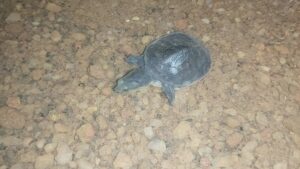SOFTSHELL TURTLES & TERRAPINS TRIONYCHIDAE (SOFTSHELL TURTLES AND TERRAPINS)
This medium to large turtles and terrapins are found in freshwater habitats. Some may also occur in brackish water habitats. They are characterized by their carapaces, which lack horny scutes (leading to the name softshells), and are leathery and malleable, especially at the sides. Their feet are webbed and each bears only three claws. They have elongated, soft, snorkel-like nostrils and very long necks. Most species are carnivores, with diets comprising mainly fish, aquatic invertebrates, amphibians, and sometimes birds and small mammals. About 30 species are distributed in Africa, Asia, and North America. A single species occurs in Sri Lanka.
Sri Lankan Soft-shell/ flapshell Turtle (Lissemys ceylonensis) (Sinhala Kiri Ibba; Tamil Pal Aamai)
| Synonym | Emyda ceylonensis GRAY 1856: 268 Emyda granosa — BOULENGER 1889 partim Emyda granosa ceylonensis — ANNANDALE 1912 Lissemys punctata granosa — SMITH 1931 Lissemys ceylonensis — PRASCHAG et al. 2011 Lissemys ceylonensis — KARUNARATHNA & AMARASINGHE 2011 Lissemys ceylonensis — TTWG 2014 |


DESCRIPTION: soft shells unlike other typical terrpins have and distinguish look with and long neck with snorkel like nostrils set with a fleshy, tubate proboscis. Webbed Fingers and toes stong and long sharp claws which help them in buring themselves in the soft mud/ lose sand of river banks.
Females in this species grow larger in size than males. Female can reaching an average carapace size of 14″ inches where males average at 10-11″ inches. Slightly domed and oval shaped shell with a distinguished characteristic from other terrapins in Sri Lanka is the presence of skin flaps on the plastron for hiding the hindlimbs and the tail. the the Carapace is covered with smooth skin of adults juvenile have a granular plaited appearance with olive greyish-green and a pinkish plastron as the get older dull brownish dark maroon with a smooth Carapace.plastron off-white with plastral flaps having a tinge of pink. Albinos are occasionally recorded.
DISTRIBUTION: Widely distributed in all climatic zones up to 600m above sea level. This species Endemic to Sri Lanka.
HABITAT AND HABITS: Inhabit lakes, rivers,streams swamps,agricultural water ways, paddy fields and even salt marshes. Active after dusk this Nocturnal species during the can be seen basking during the day or half buried in loose and soft mud or sand if captured they can deliver a painful bite.
Feeds on frogs, tadpoles, fish, watersnakes, crustaceans, mollusks, snails,earthworms, insects and water plants, and also scavenges on animal corpses far from water bodies. During the height of dry season activates by burying itself into the mud in tanks or sand in dried strems
BREEDING Oviparous females lay 2-10 eggs in a clutch the egg are presumably laid and hatch in the rainy season egg are buried into the sold and hatch after an incubation period of nine months eggs measure 25mm-33mm hatching measure around 45mm-50mm


References
- “ITIS standard report – Lissemys ceylonensis (Gray, 1856)”. Integrated Taxonomic Information System. Retrieved 25 August 2019.
- “Lissemys ceylonensis (GRAY, 1856)”. The Reptile Database. Retrieved 8 May 2018.
check out – Indian Black Terrapin (𝘔𝘦𝘭𝘢𝘯𝘰𝘤𝘩𝘦𝘭𝘺𝘴 𝘵𝘳𝘪𝘫𝘶𝘨𝘢)




